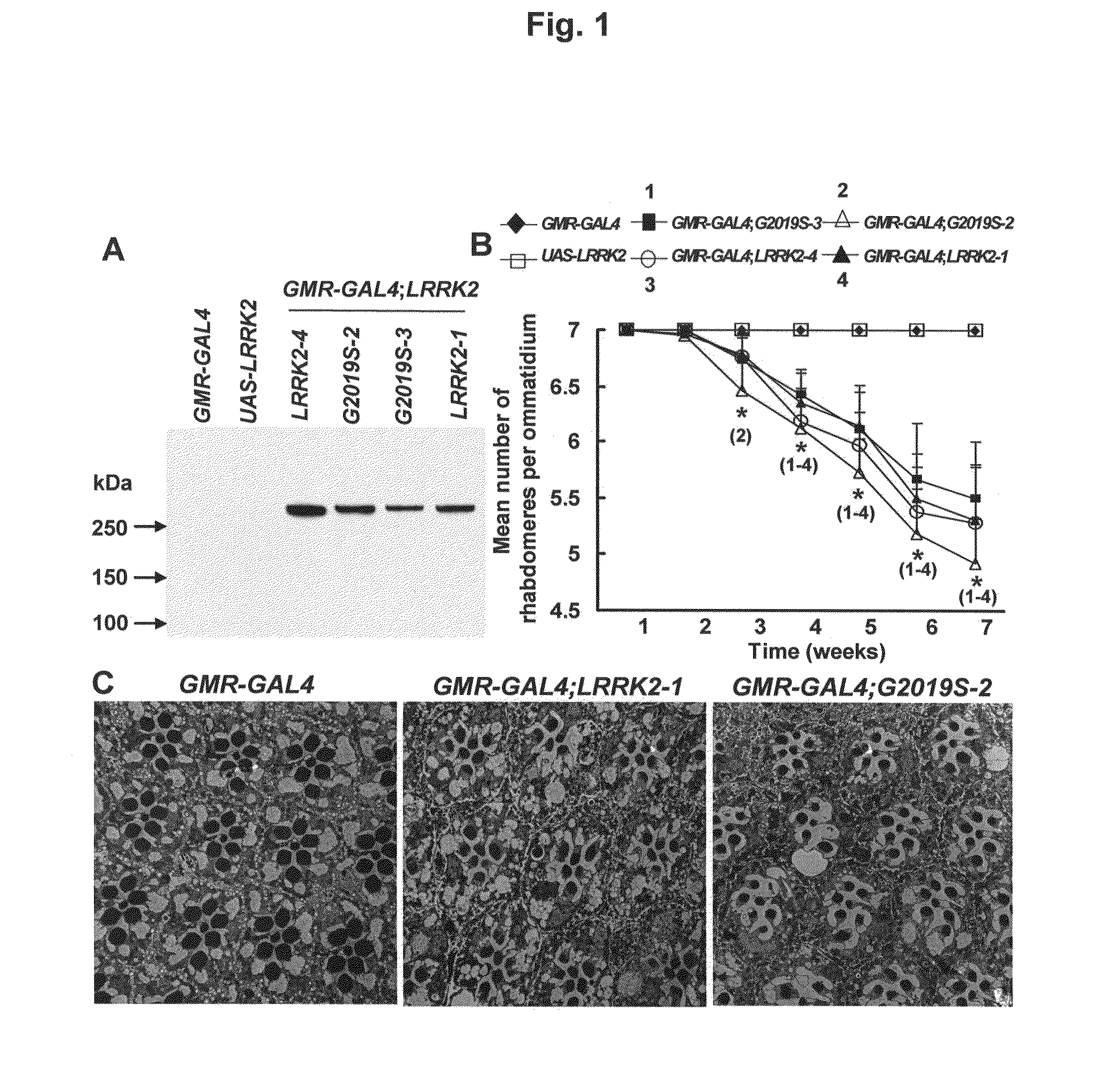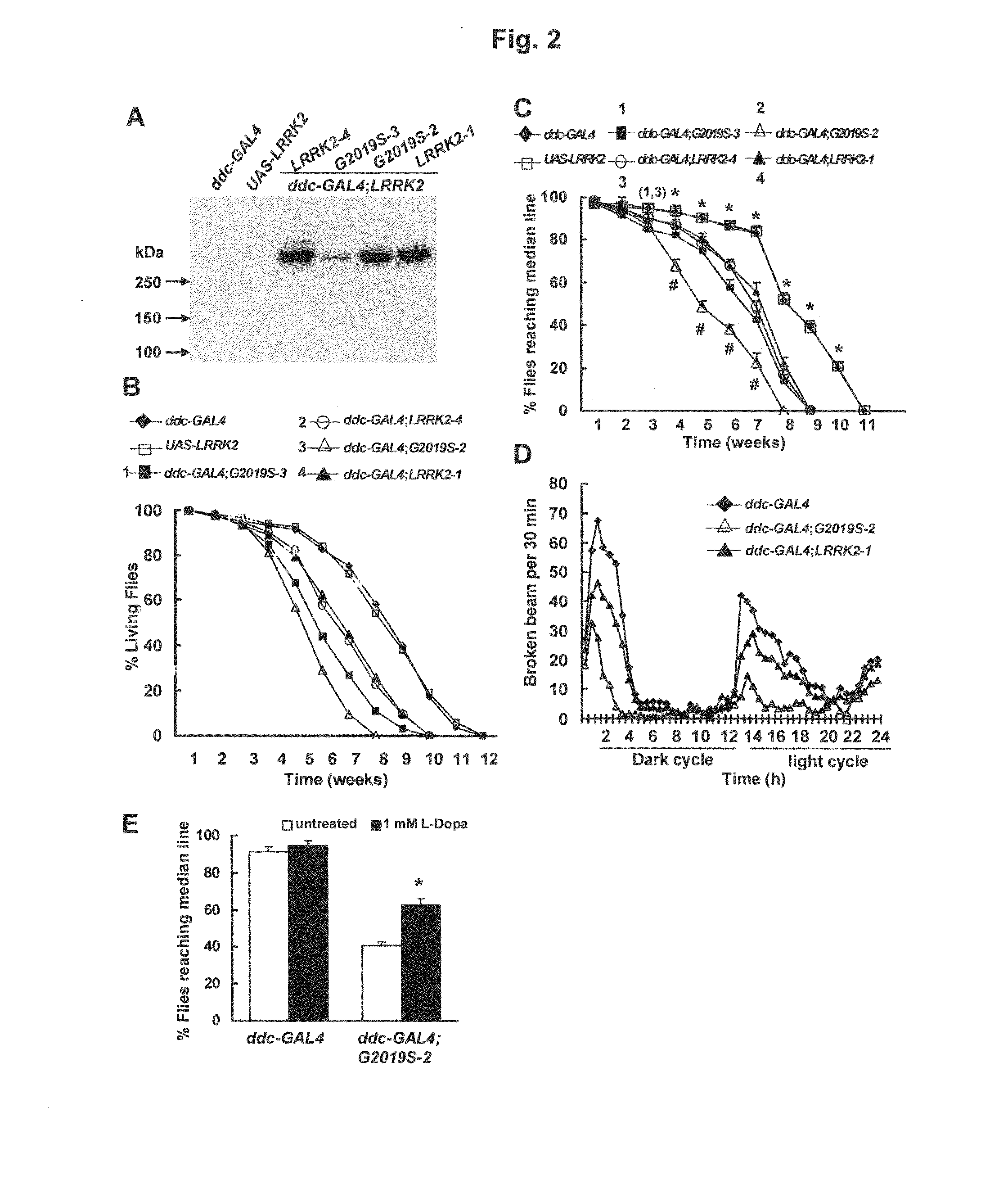Leucine-rich repeat kinase (LRRK2) drosophila model for parkinson's disease: wildtype1 (WT1) and G2019S mutant flies
a technology of leucine-rich repeat kinase and parkinson's disease, which is applied in the field of transgenic drosophila expressing human leucinerich repeat kinase 2 (lrrk2) genes, can solve the problems that the loss-of-function mutation of i>drosophila /i>cg5483 does not constitute an adequate model for the most common forms
- Summary
- Abstract
- Description
- Claims
- Application Information
AI Technical Summary
Benefits of technology
Problems solved by technology
Method used
Image
Examples
example 1
LRRK2 Induces Retinal Degeneration
[0088]To address whether overexpression of wild-type human LRRK2 and the mutant LRRK2-G2019S phenocopy the human disease in flies, we introduced these proteins in specific subsets of cells using the GAL4 / UAS system (20). This system takes advantage of the yeast GAL4 transcription factor, which binds specifically to the upstream activation sequence (UAS). Thus, UAS-linked transgenes can be expressed in specific cell types under the control of a given promoter (promoter-GAL4). To determine whether introduction of LRRK2 and LRRK2-G2019S causes a parkinsonism-like phenotype, we first assayed for retinal degeneration, because photoreceptor cell death has been used to assay neurodegeneration in other fly models of PD (18, 21). Therefore, we expressed two lines of UAS-LRRK2 (1 and 4) and two lines of UAS-LRRK2-G2019S (2 and 3) in photoreceptor cells, under the control of the glass multiple reporter (GMR)-GAL4. Using antibodies directed against the N-termin...
example 2
Expression of LRRK2 by ddc-GAL4 Causes Early Mortality and Locomotion Impairment
[0089]To express LRRK2 in DA neurons, we combined the UAS-WT-LRRK2 and UAS-G2019S-LRRK2 transgenes with the dopa decarboxylase (ddc)-GAL4 driver. Using an anti-Flag antibody, both wild-type and mutant LRRK2 were readily detected in fly head homogenates (FIG. 2A). Survival curves used to examine whether expression of either LRRK2 or LRRK2-G2019S in DA neurons affected fly viability revealed that expression of either LRRK2 or LRRK2-G2019S caused premature mortality (FIG. 2B), although expression of mutant LRRK2-G2019S caused more severe mortality at equivalent expression level (FIGS. 2A and B). The ages at which 50% of the LRRK2-1 and G2019S-2 transgenic flies survived were 48 and 38 days, respectively. The G2019S-3 line had much lower expression than wild-type LRRK2-1 but had a faster rate of mortality (FIG. 2 B). To measure the behavioral differences resulting from expression of LRRK2 in DA neurons, we u...
example 3
LRRK2 Induces DA Neuronal Degeneration
[0091]Six neuronal DA clusters are normally present in each Drosophila adult brain hemisphere (22, 23). These neurons express tyrosine hydroxylase (TH), which is an enzyme required for the biosynthesis of dopamine. Flag-LRRK2-linked immunofluorescence was evident in neurons of all DA neuron clusters and colocalized with anti-TH immunostaining (data not shown). To assess whether expression of LRRK2 resulted in degeneration of DA neurons, brains from transgenic flies at 1, 21, 35, and 49 days after eclosion were dissected and immunostained with anti-TH antibodies. In control flies (ddc-GAL4 or UAS-LRRK2 flies), the DA clusters did not change significantly in number or morphology during aging, as monitored by anti-TH staining (FIG. 3B). At 1 day after eclosion, there were no differences in anti-TH-positive staining between the control and LRRK2 or LRRK2-G2019S flies (FIG. 3B). However, at 5 weeks of age, anti-TH staining decreased significantly in ...
PUM
| Property | Measurement | Unit |
|---|---|---|
| temperature | aaaaa | aaaaa |
| pH | aaaaa | aaaaa |
| pH | aaaaa | aaaaa |
Abstract
Description
Claims
Application Information
 Login to View More
Login to View More - R&D
- Intellectual Property
- Life Sciences
- Materials
- Tech Scout
- Unparalleled Data Quality
- Higher Quality Content
- 60% Fewer Hallucinations
Browse by: Latest US Patents, China's latest patents, Technical Efficacy Thesaurus, Application Domain, Technology Topic, Popular Technical Reports.
© 2025 PatSnap. All rights reserved.Legal|Privacy policy|Modern Slavery Act Transparency Statement|Sitemap|About US| Contact US: help@patsnap.com



